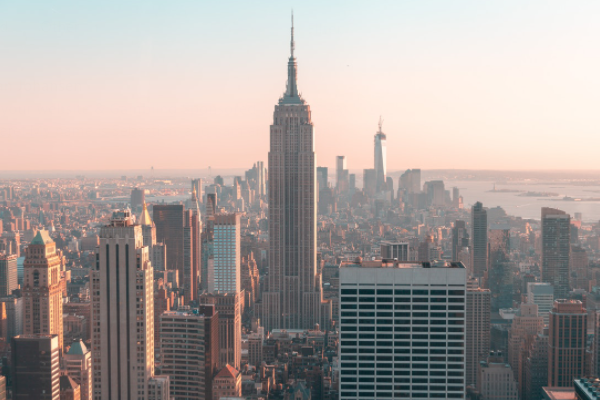 Mayor Bill de Blasio, Council Speaker Corey Johnson, and Department of Transportation (DOT) Commissioner Hank Gutman today released the New York City Streets Plan.
Mayor Bill de Blasio, Council Speaker Corey Johnson, and Department of Transportation (DOT) Commissioner Hank Gutman today released the New York City Streets Plan.
It’s a guide for the development of bus, bicycle, and pedestrian infrastructure over the next five years.
This plan, which lays out ambitious goals and makes sweeping recommendations for future plans, will help New York City equitably deliver Vision Zero projects and ensure the safe, sustainable movement of people and goods.
- 150 Miles of physically or camera-protected bus lanes
- 4,750 Transit signal priority at intersections
- 250 Miles of protected bike lanes
- 2,500 Bus stop upgrades like benches, shelters, and real-time passenger information
- 2,000 Redesigning signalized intersections
- 2,500 Accessible pedestrian signals at intersections
- Assess and amend commercial loading zones and truck routes
- Develop parking policies to promote the master plan’s goals of safety, mass transit use, reduced vehicle emissions, and access for individuals with disabilities
- Create and maintain one million square feet of pedestrian space.
New Cycling Connections: DOT will identiy locations with significant demand for new cycling/pedestrian bridges that could provide safer, more direct routes (such as Newtown Creek, Coney Island Creek, Hunters Point/Roosevelt Island), and initiate concept design studies. DOT will also explore introducing more high-capacity bikeways on our major bridges, as was just implemented on the Brooklyn Bridge, and coordinate with MTA to add or improve pedestrian and cycling accommodation on MTA bridges.
Curbside Management & Parking
Prioritize parking efficiency: DOT plans to increase meter parking in some of the densest parts of the city, with different prices for certain vehicles, to free up space for deliveries and other curb uses.
Sustainability & Resilience
Mitigating Urban Highways: DOT will prioritize community planning to develop redesigns to the City’s highway system that are either underutilized or have negatively impacted the health of surrounding residents, similar to Sheridan Blvd. The DOT has already committed $2 million to study the negative impacts of the Cross-Bronx Expressway and possible improvements.
As more and more people decide to take alternative modes of transportation to get to their destinations, we need to set up all the proper safety measures to ensure pedestrians and cyclists are kept out of harm’s way…
“As more and more people decide to take alternative modes of transportation to get to their destinations, we need to set up all the proper safety measures to ensure pedestrians and cyclists are kept out of harm’s way,” said Council Member Ydanis Rodriguez, Chairman of the Transportation Committee. “I hope that as the City continues to redesign and reimagine the City’s streetscape, we must prioritize our immigrant, Black, Latino, and Asian communities who have been historically left behind. I look forward to continuing to work alongside Mayor de Blasio, Speaker Johnson, DOT Commissioner Gutman, and transportation advocates to ensure we are building a streets plan that prioritizes equity and the safety of all New Yorkers.”
“I am excited by today’s release of the New York City Streets Plan,” said Council Member Antonio Reynoso. “This plan offers a blueprint for how we can make New York City’s streets better reflect the needs of all New Yorkers, while also providing a framework for how we can ensure that equity will be at the center of every each and every redesign proposal. It is time to return our streets to the common good that they are, and the steps in this plan will help us do just that.”
“We were proud to be part of the advocacy that led to the NYC Streets Plan and we are very proud today of the expansive blueprint it has set forward for the future of our city. We are especially energized by many of the transformative ideas advanced, ranging from next-generation cycling greenways to disincentivizing deadly SUVs. Making this plan a reality will require continued focus, smart investment, and political will, and we are eager to partner with the Adams administration to put people first on our streets – especially in communities that have long been underserved. We thank the NYC DOT team for their many months of hard work in putting together this plan. These steps are how we can make streets a pathway to recovery and make a stronger, fairer, healthier city for generations to come,” said Danny Harris, Executive Director of Transportation Alternatives.
“Bus riders urgently need faster, more reliable commutes, which the mayor promised in the New York City Streets Plan. The plan out today from City Hall takes a reasoned, comprehensive approach and a meaningful step toward equitable streets. As required by law, the next administration must make much better buses a top priority. New York can’t claim to be the greatest city while millions of New Yorkers are forced to rely on the slowest buses in the United States,” said Riders Alliance Policy & Communications Director Danny Pearlstein.
“This is a much-needed, forward-looking plan that will transform the City’s streets and improve the daily experience for residents and commuters, with a focus on equity to prioritize communities that need these benefits the most. Transportation is the largest source of greenhouse gas emissions and New Yorkers need clean transportation options. From more walkable streets to safer bike infrastructure and more efficient bus lanes, the Mayor, City Council, and Speaker have demonstrated vision, leadership, and collaboration that will benefit our City for generations. We look forward to working with Mayor-elect Adams, NYC DOT and the Council to implement this plan on our streets efficiently and effectively,” said Julie Tighe, President of the New York League of Conservation Voters.
Become a Harlem Insider!
By submitting this form, you are consenting to receive marketing emails from: . You can revoke your consent to receive emails at any time by using the SafeUnsubscribe® link, found at the bottom of every email. Emails are serviced by Constant Contact








